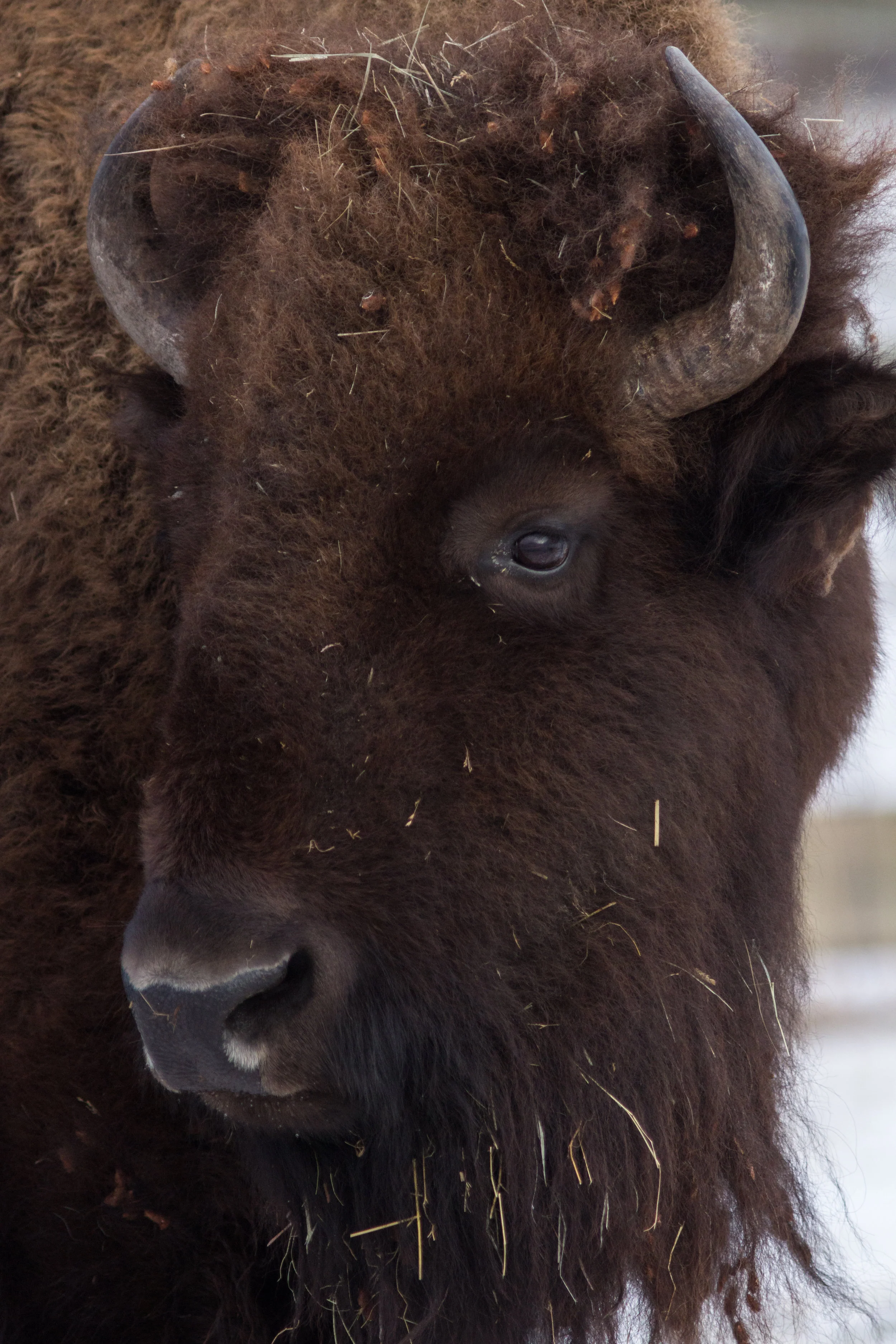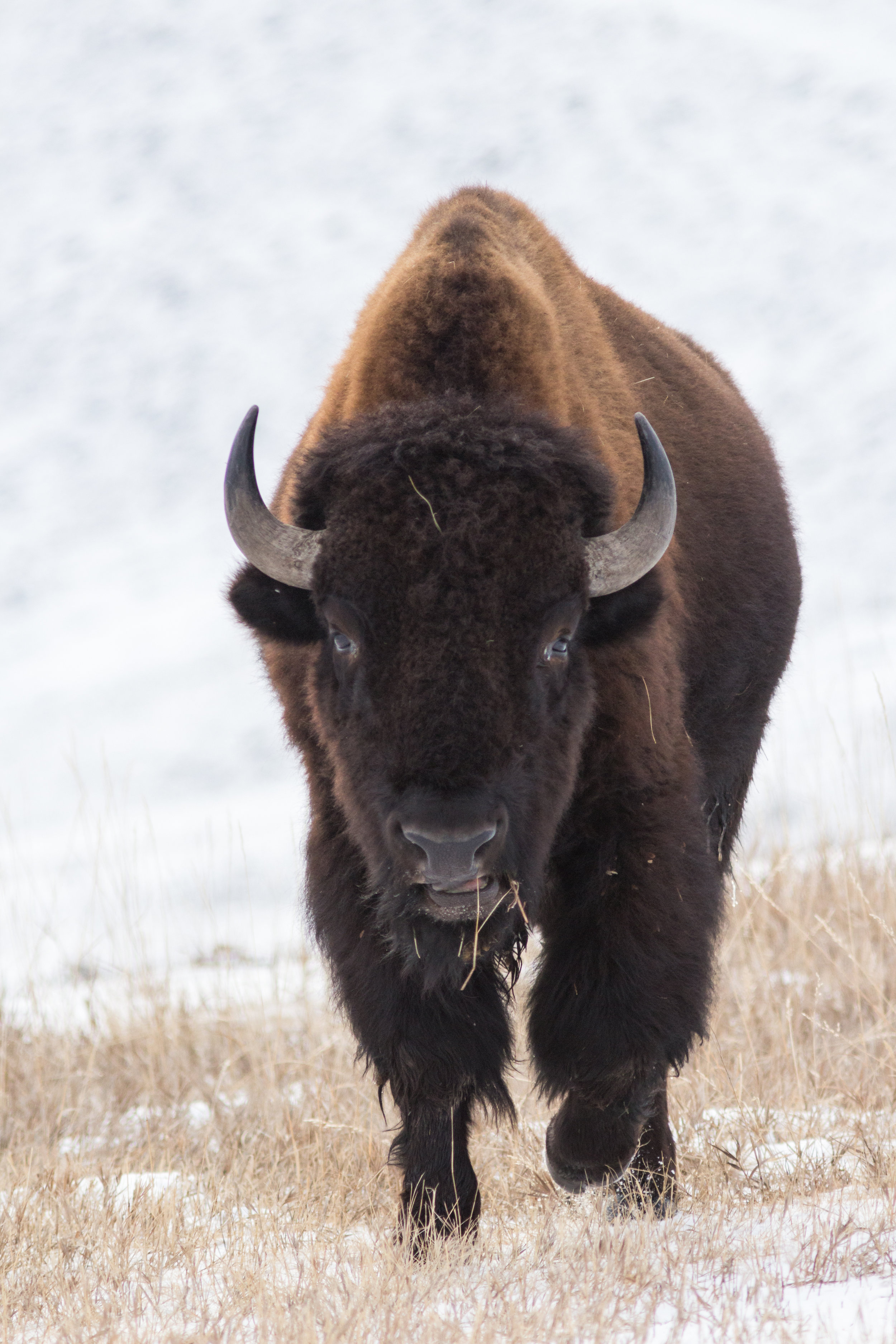Often standing in the middle of the road, rolling around in a field, or clumsily treading around (sometimes through) geysers and hot springs, Yellowstone’s bison are nothing short of a natural wonder. America’s largest land animal lumbers with a majestic presence— both a relic of the past and an icon of successful conservation. In Yellowstone, there are some 4,600 bison, creating endless photographic potential. Indeed, Yellowstone has to be one of the best places to photograph bison on the planet. Unfortunately, everyone knows this. Yellowstone, famous for its bison herds and geysers, can be a nightmare for photography. For one, there are tourists packing in by the bus-full, everywhere. Without trekking into the backcountry, you’re bound to find tourists crowding most any photographic vantage point. Even the most unsightly of bison is bound to have a foreign tourist, clad in bucket hat and crocs, and wielding an iPad, trying to photograph the bison. Not only does this ruin your photo, but often scares off the bison or provokes them to charge, creating a danger for everyone.
However, a herd of bison, nearly 2,000 strong, freely roams the open prairie that most people have never heard of. It’s a land of solitude— sparsely populated and pristinely preserved. You can drive for miles surrounded by too many bison to count without seeing so much as another car or two. This is Custer State Park in South Dakota and it’s hands down one of my favorite places to visit.
Located on the western edge of South Dakota, Custer State Park is about a 30-minute drive from Rapid City. It borders Wyoming as well as Wind Cave National Park, not too far from Mount Rushmore. The park itself consists of almost endless rolling prairie, upon which the bison roam, but also houses several large prairie dog colonies, deer, coyote, and wolves. It’s almost like baby Yellowstone. However, the advantage of Custer State Park rests in its seclusion. There are no tourist buses there, which in and of itself, is a gift from God. One can hike only a mile or so off the road and be surrounded by nothing but open space and the occasional bison. Most importantly, because of the remote nature of the park, it offers unique potential for more personal encounters with nature.
Last spring I made my first trip to Custer and have been itching to return ever since. As stunning as the bison were, I had in my mind a photograph a lone bison, coated in a thick layer of snow, breath condensing in the cold winter air. I had previsualized this image, dreamed of it even, for months and I was anxious to try to execute. Thus, a few months back I returned to South Dakota.
We had landed in Rapid City and spent our first morning touring Badlands National Park, as we wanted to get to Custer for sunset. We left Badlands in the early afternoon, just as a blizzard rolled in. Fighting our way through the storm, we were encouraged by the fact that the bison in Custer would be coated in snow. If the sun came out towards sunset, I figured I’d get the photo I had dreamt of: a bison coated in snow, humid breath lit by the setting sun.
We arrived in Custer an hour or so later to find the park covered in snow but no longer snowing— the clouds has begun to part. Making a beeline for the visitor center I needed to know where the bison before the snow began to melt.
“They’re always around wildlife loop road,” the friendly ranger reminded me. “But this time of year most of them are still in the corrals. Down here,” she said, motioning to a spot in the south part of wildlife loop road.
“Corrals?” I thought, “what do you mean corrals?”
In my single prior experience at Custer, it had been a land of free-ranging bison, rolling hills, and prairie dogs. What I quickly came to learn was that in order to maintain both the park and the herd, the bison were corralled in the winter and provided plenty of hay to eat. The ranger did provide me some hope, suggesting that while most of the bison would be in the corrals, that some of them would also be outside, wandering around.
“Oh, and because of the recent burn,” the ranger added, “the prairie dogs have been severely reduced. Not that you’d want to get near them anyways; they have the plague.”
As in, the Black Plague. Ring around the rosie/pockets full of posie/Bison! Bison!/All the prairie dogs are dead. So as if it was bad enough that the bison were in corrals, I couldn’t even try to get a prairie dog photo instead.
Driving down to the corrals, hoping that what the ranger had said wasn’t true, I came over a hill and at once lost all hope. There was no way I was going to get the shot for which I came. Almost the entire herd of bison gathered in a massive fenced-in corral. To rub salt in the wound, coating the corral wasn’t a fresh layer of silky white snow, but rather a fresh layer of bison scat and green-yellow hay. With fences in the background and poop inevitably in the foreground, there wasn’t a chance of getting a shot of a snow-covered bison roaming the open prairie. Indeed, most of the bison didn’t have any snow on them at all.
Nonetheless, the corral did have its advantages. For one, you could safely get within a close distance of the herd and could watch how they interacted. Certain bigger bison would wander one way and a few of the smaller ones would follow, this bison would shove that bison to get a better angle on the hay bale, the calves would hover around the legs of their mothers. Most interesting, about 20 yards from where I stood, two bison butted heads (literally) in a powerful and bone-rattling dance. The clonking of skulls produced this horrific bone-on-bone noise; each time they collided, my insides turned around. You could ever feel the awesome power from the blows. One head would ram the other, then slam sideways against the side of the other’s head as they interlocked their horns. Yanking and twisting their heads, they’d pull and strain the neck of the other, before one broke the lock and then clashed skulls again. The beefy necks of the beasts would shake and strain, their legs both driving forward and then stumbling to find ground. Despite to horrific noise, I could have watched this heavy-weight prize fight for hours.
Although it was unfortunate the bison were corralled, watching them up close still proved extremely entertaining. Never before have I stood so close to such large, wild animals. We watched and photographed them for a while, before we went to our hotel.
Weighing our choices for the next day, we decided we’d return to Custer for sunrise (great decision), check out the bison again, and then drive over to Wind Cave National Park, both to find bison (hopefully unenclosed) and tour the cave.
Waking at what felt like the buttcrack of dawn, we headed into Custer to watch the sunrise, knowing that the rolling hills, now coated in snow, would make for a picturesque landscape. As with the longhorn sheep, I got incredibly lucky again. As the sun rose over the horizon the sky lit up a beautiful shade of indigo with splashes of crimson and Cadillac pink. The rolling hills of Custer State Park reflected the deep blue, contrasting the brighter splashes of warm color. The result stunned me; I rushed between different vantage points trying to find my favorite composition, each composition seemingly better than the previous.
Once the color had faded, we took our time driving back to the corrals. Rather than rush to take bison scat photos, we focused on photographing the other wildlife in the park the fascinating landscape. A massive prairie fire a few months before we got there charred Custer and Wind Cave, leaving the landscape black as death underneath the layer of pure white snow. The fire obliterated the landscape, toasting the trees a shade of brownish-black, incinerating any leaves. It resulted in a bizarre and slightly morbid beauty and also created a simple color palette: white, black, and caramel. The minimalist prairie landscape finally had a fitting tonal range. Had we had more time with good light (the clouds rolled in quickly after sunrise), this bare landscape would have yielded myriad compositions for solid landscape photography.
Unfortunately, as with all of my trips, we didn’t have much time— just two and half days. Thus, although the photography wasn’t spectacular, we just enjoyed the scenery. We returned to the bison corrals for a while, where a lone bison escaped and kindly posed as he walked towards me. Getting within a few yards of where I stood, I assumed he just wanted to see what he looked like on camera. I ducked into the car and backed up several yards before climbing out to continue shooting. We played this game of slowly backing up for a while before we decided to leave my new friend be and went in search of Wind Cave.
Although I didn’t get the photograph that I came to Custer State Park to take, my experience watching the bison interact proved more than enough reason to visit the park. The fact that I got gorgeous landscapes at sunrise and that a lone bison posed for photographs was simply a bonus. Honestly, my lack of success photographing the Custer bison in the winter makes me want to return to that incredible park as soon as I can. Although, I think I’ll wait until after the prairie dogs get over the bubonic plague.






